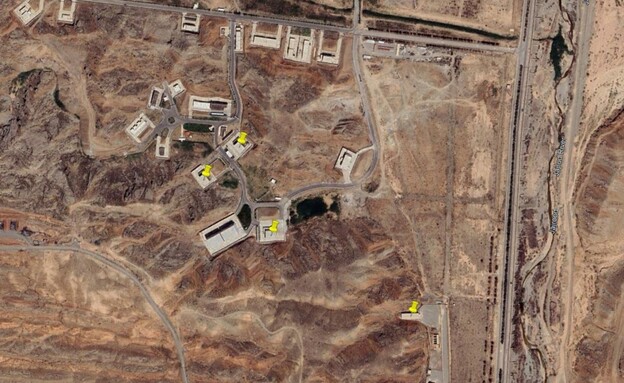@planet 3m imagery taken this morning of Khojir and Parchin missile production facilities show precise strikes on warehouses and mixing buildings associated with the production of solid-fueled ballistic missiles. pic.twitter.com/Qpodu4pN5m
— Decker Eveleth (@dex_eve) October 26, 2024
The affected sensitive facilities are located in the Farchin and Khojir area, east of Tehran. This facility is known, among other things, for its secret part in Iran’s nuclear program, and in the past a mysterious explosion was reported there. In July it was reported in Reutz that the facility in Perchin is undergoing a major expansion process.
The sensitive area of the facility in Hujir
According to the report tonight in Reuters, around the sensitive buildings that were attacked there were high earthen embankments designed to prevent damage to them. At least two sensitive buildings were destroyed at the facility in Hujir and three more were destroyed at the facility in Parchin. “These industrial mixers are very difficult to obtain and import,” Elbeth said, and according to Reuters, Tehran is expected to find it very difficult to renew the damaged facilities.
The sensitive facility area in Parchin
Yesterday it was reported on the Saudi “Ilaaf” website, known as a website with good sources in Israel, that Israel destroyed a large amount of fuel mixers, the value of each of which is at least two million dollars. Sources familiar with the Iranian missile industry told the Saudi website that it will take at least two years to get the plant back into operation, as Israel has fundamentally disrupted Iran’s missile production capabilities.
Sources in Iran and Israel told the New York Times that Israel destroyed in the attack air defense systems that protect the country’s oil, gas and petrochemical industries. Because of this, there is now a heavy fear in Tehran that these facilities will now be exposed to further future attacks.
Among other things, air defense systems were attacked on the night between Friday and Saturday at the Bandar Imam Khomeini petrochemical complex in Khuzestan province, and at the large economic port nearby, which bears the same name. Air defense systems were also attacked at the refinery in Abadan, and at the gas field in Ilam province called Tange Bijar. Yesterday it was reported in the New York Times that Israel also destroyed an air defense system at the Khomeini International Airport in Tehran.
The Bandar Imam Khomeini petrochemical complex
The gas installations that were attacked in the province of Ilam
“Israel is sending us a very clear message,” Hamid Hosseini, an expert in Iran’s gas and oil industry, told the New York Times. “This could have very serious economic consequences for Iran, and now we understand the risk and that we must act wisely and not continue with tensions.”
Two Israeli sources told the American newspaper that the original plans for the attack on Iran were developed and formulated immediately after Iran’s missile attack at the beginning of the month. Those plans included hitting targets related to Iran’s energy industry as well as its nuclear program. Despite this, against the backdrop of heavy pressure from the US not to attack targets related to Iran’s energy and nuclear fields, Israel eventually attacked air defense systems around energy facilities, but not the facilities themselves.
Last night, Netanyahu’s office issued a statement in which it denied reports that Israel stopped an attack on Iran’s gas and oil facilities due to American pressure, and called the report on the matter “completely false.” “Israel chose in advance the targets of the attack in accordance with its national interests, and not according to American dictates. This is how it was and how it will be,” the statement said.
The report in the New York Times also shows that after the Israeli attack, an emergency meeting of the Supreme Council for National Security in Iran was held yesterday in Tehran. Army commanders informed the council members about the extent of the damage and the targets that were hit. Three official sources in Iran said that the council discussed Iran’s possible response, but no decision was made on the matter.
Israeli officials said that the attack “set back” Iran’s ability to build missiles, but Iran rejected the claim and said that the damage was “minor” and that the strike was only short-term. Ali Vaez, an Iran researcher, told the New York Times that the attack this weekend appears to be a potential preparation for a much more significant attack later against Iranian infrastructure and nuclear facilities. “Iran does not have the ability to decide which facilities were damaged in the near future,” he said.

Arden's Garden Juice Bar & Smoothies Stone Mountain – Food & Beverage – East Haddam Business
meet reformasorce – h-node.org
Certificate verification problem detected
rosinalester – Users – TRCA Open Data
ComplaintCategories – All Items
shadowclutch8 – Music – HulkShare
Website Suspended
Website Suspended
Lucky11: Your Go-To Online Gambling Hub: Home: Lucky11: Your Go-To Online Gambling Hub
Open Discussions
Lice Busters in Brooklyn :: Behance
mmudanzasplata | Experiment
Roofing system Repair Work: Some Factors to consider | Article One
hub.docker.com/u/darrelbica
VaporPlanet10
reinacamacho – Profile – Encyclopaedia Metallum: The Metal Archives
robyngalindo | Mbed
vaporplanet00pt Publisher Publications – Issuu
Akses Perjudian Daring dengan Mudah dengan Tautan Alternatif Dultogel – Jonitogel
The Basics of Property Monitoring | Articles@PR4
User Profile
Neighborhood Link – Profile for owencraig
Page not found – Powerful Business Listing Technique to Advertise Offered Services
Descubre el Paraíso en Costa del Sol | Business & Services – Free Do Follow Social Bookmarking Sites
Database Error
Activity – Rodriguez Funch – ContestAlert.in
pittsburghendthewar.org
stephinedavison – Profile – Design Addict Forum
The Importance of Specialist Cleansing Providers for Homes and Companies